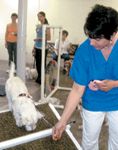How to start a successful behavior program
This case study shows how to strengthen your relationships with clients, build their bonds with their pets, and grow your practice.
You have a vision for a new behavior program for your practice, and it's going to be great. It's going to strengthen the bond between clients and pets, maximize patients' well-being, and help your practice and your team grow. The only hitch: You need your doctors and team members to think it's a great idea, too.
Of course, it's up to your doctors to determine whether the programs fits your practice's mission. After all, the doctors must get on board first, and then the team needs to plan and train thoroughly before introducing a program to clients.
To jump-start the planning process and help build buy-in, set aside time during a team training session or staff meeting to discuss your ideas and uncover any obstacles. Those who've helped launch new programs will tell you team members must accept the new idea if you want it to be successful. They must support the program and those who lead it by participating with their own pets and delivering a consistent message about the program's importance to clients.
This practice invested the time and money to teach all of its team members how to educate clients and make consistent recommendations. Consider their advice to launch a successful program in your practice.
Blast off with a behavior program
Preventing canine behavior problems before they begin is the goal of the behavior training program at Nassau Veterinary Clinic in Nassau, N.Y. Sixteen years ago, the practice was losing its share of patients to shelters because of behavioral problems. So practice manager Florence Sanford, CVPM, hired Marlene Wagner, a veterinary assistant and Certified Pet Dog Trainer (CPDT), to start a positive, reward-based training course to bond clients and pets from puppyhood and preserve their relationship with the practice. Wagner and her team of trainers, which includes two clients with experience in agility and rally obedience training and classes, plan and teach the courses one night a week.
An alternative to traditional obedience training, the initial course, "Basic Life Skills, or More Manners Please," taught pets to be good household citizens in a fun, gentle, and instructive way. Today, the single class has expanded into a series, which kicks off with free monthly puppy parties, followed by puppy kindergarten, adolescent finishing school, a beginners' agility or rally obedience course, and an American Kennel Club Canine Good Citizen course. Each five- to eight-week course, which costs $95 to $125, uses the skills developed in the preceding training courses.

Figure 1
Nassau Veterinary Clinic also offers a secondhand dogs course for adopted dogs and their owners. And the practice's responsible pet owners program entitles clients who have completed at least one training course to a discount on their pet's ovariohysterectomy or neuter. In June, the team launched a new program called "Tails on Trails" that provides clients and their pets the opportunity to practice what they've learned in two or more previous training courses in a public setting, such as a shopping center or park.
Do it yourself
The National Council on Pet Population Study and Policy reports behavior problems are the top reason Americans relinquish their dogs to shelters. In 2007, 36 percent of puppies that visited Nassau Veterinary Clinic for puppy visits enrolled in puppy kindergarten, and 149 dogs took behavior courses at the practice. To launch an effective behavior program, consider these steps:
- Establish a vision. Determine what your team wants to accomplish so you know how to train pets. For example, if a goal is to strengthen the relationship and build trust between clients and pets, Wagner recommends employing positive, reward-based training methods with treats, toys, and play.
- Identify trainers who fit your practice's vision. Veterinary assistants who excel at teaching clients in the exam room are obvious candidates, but don't overlook other team members with a passion for training. "I'll bet in every hospital there's somebody who spends a lot of time training their own pets and who's dedicated to training," Sanford says.
When looking for trainers outside the practice, Sanford suggests hiring a CPDT. Wagner holds this national certification for experienced dog trainers, which is grounded in humane training practices. All CPDTs have at least 300 hours of dog training experience, have passed a standardized exam covering five areas of dog training, follow a code of ethics, and are required to complete continuing education.
- Invest in training and continuing education. Practice managers: Your role is to give trainers education, goals, and incentives to help build the program. Wagner and the other trainers at Nassau Veterinary Clinic attend the Association of Pet Dog Trainers annual conference and at least two local seminars a year.

Marlene Wagner and Florence Sanford, CVPM, with Lieka, a Greater Swiss mountain dog Wagner trained for therapy work.
Sanford encourages every member of the behavior training team to participate in local seminars by paying the cost of the registration, and trainers will also share highlights from educational events with the rest of the practice team.
- Start without dogs. New instructors might consider holding an educational seminar just for clients before bringing dogs into the picture. This approach worked for Wagner, who limited the first class of the practice's original life skills course to pet owners only.
- Encourage the whole team to participate. Every team member at Nassau Veterinary Clinic talks up puppy parties to pet owners during puppy visits, which is easy since many of them have attended the parties and participated in training courses with their own dogs. To encourage participation, the courses are free to team members.
Many doctors' and team members' shifts end while class is in session, and they follow a practice rule to stop in to give treats, cuddle a puppy, or say hello to clients on their way out, Wagner says.
- Use your practice management software to help market the program. The practice team codes first puppy visits in the software system and includes a puppy party invitation and a behavior program brochure in the practice's puppy packs. Wagner later uses the software to generate a list of new puppy patients seen since the last puppy party and follows up with a personalized message addressed to the puppy.
The benefits
By preempting behavioral problems, the team at Nassau Veterinary Clinic has helped keep most of its patients in homes and out of the shelter. Canine students are excited to visit the practice for school, and the pooches rarely behave poorly because they've learned in class to relax during handling.

Marlene Wagner leads a terrier puppy over a mini-agility obstacle during a puppy kindergarten class.
Another plus: The team is able to increase touch time with patients and clients and expand on exam room education topics, such as vaccinations and potty training tips, during puppy parties and puppy kindergarten. The program also offers a career growth opportunity for team members to expand their skill set and their pay. Inexperienced team members who are interested in teaching classes might consider apprenticing with veteran trainers or volunteering with shelters and rescue groups.